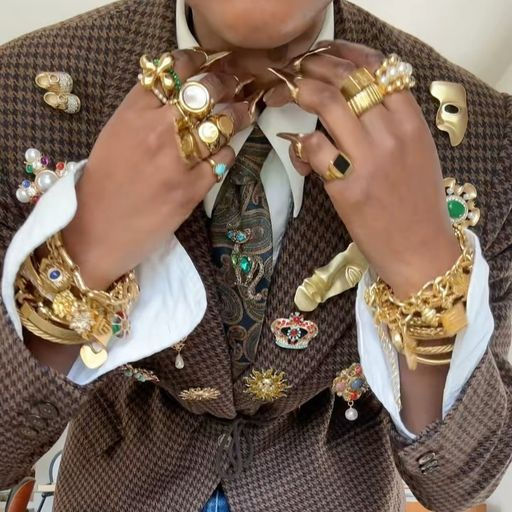Quiet Luxury Is Out, Frugal Fashion Is In: The 2025 Shift Explored
- Zara Bukhari
- Jul 28
- 4 min read

In the fashion world of 2025, silence no longer signals sophistication; value does. Quiet luxury, once the hallmark of the elite and the discreetly stylish, has given way. In its place rises a louder, bolder, and more budget-conscious trend: Frugal Fashion.
But don’t confuse “frugal” with “cheap.” This is not about deprivation. It’s about the reinvention of style, status, and spending power. Fashion today isn’t just reacting to runway shifts, but to rising inflation, slowing economies, and the psychology of a post-pandemic consumer who wants more for less and knows how to get it.
The Quiet Exit of Quiet Luxury
The turn away from quiet luxury is not speculative; it’s declared.
Earlier this year, the U.S. CEO of LVMH stated that the trend was “getting pretty annoying,” calling time on a movement that once dominated both fashion media and investor optimism. It’s a rare moment when a luxury executive so bluntly admits a trend’s demise and a clear indicator that fashion is entering a new chapter.
By Q1 2025, sales in premium luxury segments fell by 5.7% globally, with brands like Brunello Cucinelli, The Row, and even Celine underperforming market expectations. In contrast, affordable fashion brands either beat estimates or raised guidance.
This isn’t just about aesthetics, investor capital is shifting. Quiet luxury, rooted in muted colour palettes and silent logos, no longer holds the cultural or financial resonance it did even 12 months ago. Consumers are fatigued. Investors are cautious. The minimalism boom has maxed out.
The Rise of Frugal Fashion: From Surplus to Smart
Frugal fashion isn’t a trend—it’s a response. In 2025:
77% of UK shoppers say they plan to reduce fashion spending (Just-Style, 2025)
Globally, 58% of consumers are now “shopping for value” over brand loyalty (McKinsey, 2025)
Apparel & luxury spending declined 4.2% YoY in Q1 2025, while fast fashion grew 9.1% (FashionDive, 2025)
Consumers haven’t stopped buying, they’re just buying differently. Thrift stores are booming. Fast fashion leaders like Zara and H&M report double-digit growth, while secondhand platforms like Depop, ThredUp, and Vinted are seeing record traffic.
The fast fashion market alone is projected to hit $163.21 billion by end-2025, growing at a CAGR of 15.6% (Research & Markets, 2025). Meanwhile, luxury conglomerates are under pressure to justify high margins in a world that increasingly values accessibility over exclusivity.
Financial Rebalancing: Value-Driven Market Dynamics
The shift to frugal fashion is rewriting revenue models across the industry:
Metric | 2025 Insight |
Global Apparel Market Size | $1.84 trillion, but premium growth is slowing |
Fast Fashion Growth | $141.2B (2024) → $163.2B (2025) CAGR: 15.6% |
Luxury Segment Growth | Slowed to <2% CAGR (vs. 6% in 2021–2023) |
Average Transaction Value (ATV) | Down 12.4% in luxury retail; up 8.9% in discount/value segments |
Secondhand & Thrift Market | Expected to reach $350B globally by 2028 |
Consumer Spending Behaviour | 58% shop in-store for deals, focus on essentials and longevity |
Luxury stocks like Kering and Burberry saw corrections of 10–15% in H1 2025, while shares in Inditex (Zara’s parent company) and Shein’s IPO buzz garnered renewed investor enthusiasm.
Frugal fashion is also applying pressure across the supply chain: brands are being forced to invest in automation, digitized inventories, and low-cost logistics to survive the tighter margin environment. It’s no longer enough to be stylish, you must be operationally lean and financially agile.
Y2K Maximalism: Loud Aesthetics, Low Cost
Enter the Maximalist Y2K revival, the colourful, chaotic aesthetic of the early 2000s that’s making 2025 anything but quiet. Think low-rise jeans, metallic mini-skirts, trucker hats, logo tees, rhinestones, and riotous layering.
But here’s the twist: it doesn’t require deep pockets. It thrives in the thrift economy.
Y2K-inspired fashion sales are up 40% globally YoY
Thrifting saw a 26% increase in Gen Z participation in Q2 2025 (Analyzify, 2025)
Maximalist fashion hashtags rose 125% in engagement, reflecting viral consumer appetite for colour and creativity (Pinterest Business, 2025)
Luxury brands are scrambling to keep up. Many are partnering with resale platforms, while others are investing in diffusion lines or launching capsule collections under new sub-brands to reach frugal but fashion-conscious buyers.
In this new cycle, cost-efficiency + cultural relevance = profitability.
Style as Economic Self-Expression
Frugal fashion and maximalist Y2K aren’t conflicting currents; they’re converging. Together, they tell a story about how younger consumers are reclaiming control over their wallets without sacrificing identity or excitement.
This generation isn’t rebelling against fashion. They’re demanding accountability—financial, environmental, and creative.
Instead of timeless beige coats, they want six ways to wear a thrifted denim jacket. Instead of a designer logo on a tote bag, they want stories, customization, irony, and resale value.
The future of fashion isn’t about excess. It’s about expression with efficiency.
Final Word: Investing in the Inevitable
For fashion brands and investors alike, the shift from quiet luxury to frugal fashion isn’t temporary, it’s structural. The brands poised to lead this decade are not just those selling more, but those selling better, cheaper, and smarter.
From resale integrations to dynamic pricing, the financial future of fashion is frugal, flexible, and fiercely consumer-first.
Quiet luxury may be over. But smart fashion? That’s just beginning.







Comments